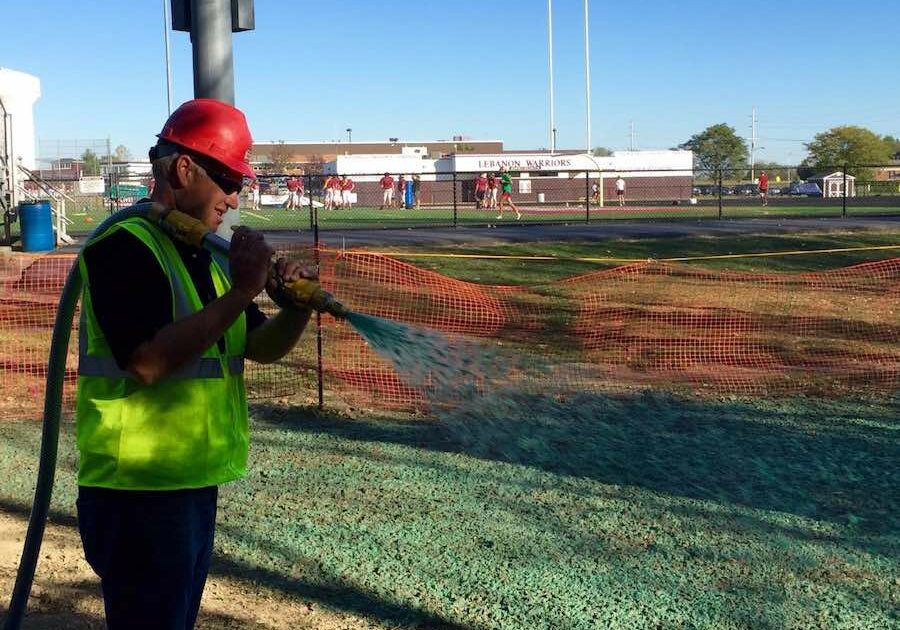Application Spotlight: Hydroseeding for Athletic Fields

Share this article!
There’s nothing like a lush, green expanse of lawn to set the stage for all kinds of games and sporting events. Hydroseeding sports grass can help you get beautiful quality grass that stands up to the tough conditions of sports fields and athletic grass.
Hydroseeding for athletic fields, from soccer fields and baseball diamonds to golf courses and school grounds, can be a quick and effective method to get high quality grass in and get the games going. Hydroseeding for these purposes is also generally much more cost effective than alternatives like sod and traditional seeding.
Why Use Hydroseed vs Sod for Sports Fields?
Using hydroseed rather than sod for sports fields saves money and time while providing a consistent result of great-looking and durable grass.
There are several reasons to consider hydroseeding for sports and athletic fields, notably the cost, the seed options, and the quality of the results.
Cost
Using hydroseed for sports fields can be significantly cheaper than laying the same amount of sod. Of all the ways to get new grass on a sports field, many landscapers know that sod is most expensive. By comparison, hand seeding is cheap, but takes a lot of time and effort and doesn’t always yield great results. Hydroseeding is an effective, efficient alternative to both sod and hand seeding that also happens to be cost effective.
For the average football field, about 1.32 acres, the price to hydroseed would be in the neighborhood of $2,000-$5,000. The cost to sod that same field would range between $13,000 and $35,000, depending on the type of grass selected and varying installation costs.
Seed Choice
Another advantage of hydroseeding for sports fields is the ability to mix grass seed types. The lush, green lawns you want for all kinds of outdoor sports can be well established by a hydroseed turf mix that incorporates several different varieties of seeds.
Different varieties of grasses thrive in different levels of soil pH, moisture levels, and sunlight levels. Using a combination of seed types helps ensure the grass is thick, healthy, and resilient,
Sod, by contrast, is generally a single variety of grass, so you can choose only one type of grass, like Kentucky bluegrass or fescue, and hope for the best while it establishes. A single variety of grass offers less diversity than a mix, and therefore provides less protection from common issues like disease, drought sensitivity, and pests.
Deeper Root System
Sod, especially certain varieties of grass sod, can struggle to root effectively. It’s important to make sure sod has the proper growing conditions as well as appropriate, and consistent, moisture levels to make sure roots establish in the soil beneath.
Using hydroseeding instead of sod can often result in a deeper, more robust root system that’s ideal for the heavy use and traffic of a sports field. With the proper amount of time, hydroseeded grass can establish just about anywhere it’s properly watered because the slurry incorporates everything seeds need to get roots down well, like fertilizer and soil stabilizing mulch.
Downsides of Using Hydroseed vs Sod for Sports Turf
Is hydroseeding ever a poor choice for ball fields? There are a few situations where sod has some very clear advantages over hydroseed, and they’re generally related to time and watering.
Field Downtime
If you need instant grass on a sports field, the right choice will always be sod, as it’s the quickest way to get grass on the dirt. Since sod arrives in pallets, the only limitation you typically face is ordering time and installation time.
Watering Requirements
While hydroseeded and sodded fields both need water to establish well, the amount of water required to start a healthy, deep root system varies based on the seeding method. Compared to hydroseeding, sod generally requires fewer, deeper watering sessions to saturate the sod itself and the soil below so the roots have a better chance at establishing in the soil.
Hydroseeded areas also need to be kept moist in the first month, but it’s generally recommended that this be done with frequent, surface-level watering.
Takeaway
Hydroseeding for sports turf, athletic fields, and school fields is an effective and often affordable choice that can produce reliable, great-looking results. Especially if you have the time to wait for grass to come in, and a bit of patience to keep the area hospitable for seeds, hydroseeding sports fields will provide grass that looks great and holds up well, season after season. For more information about hydroseeding for sports fields, as well as other hydroseeding applications, contact us today.
